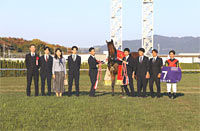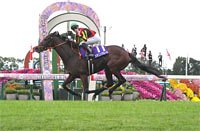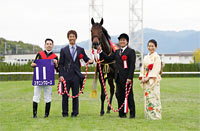Queen Elizabeth II Cup (G1) - Data Analysis
Race to decide autumn champion filly/mare
The Queen Elizabeth II Cup is a clash between 3-year-old fillies that have dominated the Triple Crown races and leading fillies/mares aged 4 and up. Over the last 10 years, 3-year-old runners have notched four wins, 4-year-olds four wins, and 5-year-olds two wins. Since 2012, runners backed as 6th favorite or lower have consistently finished in the Top 3. Let’s now look at some trends in this race, which decides the autumn champion filly/mare, based on results over the last 10 years.
Runners backed as 1st & 2nd favorites in previous race have produced zero winners over last 10 years
Looking at performances by runners over the last 10 years in terms of favoritism in the previous race (excluding runners that contested an overseas race in their last outing), we find that runners that were backed as "1st favorite" or "2nd favorite" in their previous races produced zero winners. However, runners-up and third-place finishers included a total of 10 runners that had been backed as "1st favorite" in their previous race, and a total of four runners that had been backed as "2nd favorite" in their previous race. These could be considered useful statistics when planning bet formations. [Table 1]
[Table 1] Performance by favoritism in previous race (last 10 years)
Favoritism in
previous race |
Performance
[1st-2nd-3rd-4th or lower] |
Win ratio |
Top 2 ratio |
Top 3 ratio |
| 1st favorite |
0-4-6-16 |
0% |
15.4% |
38.5% |
| 2nd favorite |
0-3-1-13 |
0% |
17.6% |
23.5% |
| 3rd favorite |
2-0-1-18 |
9.5% |
9.5% |
14.3% |
| 4th favorite |
1-0-2-12 |
6.7% |
6.7% |
20.0% |
| 5th favorite |
1-1-0-16 |
5.6% |
11.1% |
11.1% |
| 6th–9th favorite |
3-2-0-38 |
7.0% |
11.6% |
11.6% |
| 10th favorite or lower |
1-0-0-26 |
3.7% |
3.7% |
3.7% |
Note: Excluding cases when the previous race was contested overseas.
Also look at favoritism two race back
Looking at performances by runners over the last 10 years in terms of favoritism in their second to last race (two races back, excluding runners that contested an overseas race in their second to last race), we observe that runners that had been backed as "1st favorite" in their second to last race enjoyed the best win ratio and Top 3 ratio, and runners that had been backed as "2nd favorite" in such race the best Top 2 ratio. This suggests that higher favoritism in the second to last race produces stronger Top 2 and Top 3 ratios. [Table 2]
[Table 2] Performance by favoritism in second to last race (last 10 years)
Favoritism in second
to last race |
Performance
[1st-2nd-3rd-4th or lower] |
Win ratio |
Top 2 ratio |
Top 3 ratio |
| 1st favorite |
3-2-7-20 |
9.4% |
15.6% |
37.5% |
| 2nd favorite |
1-4-1-19 |
4.0% |
20.0% |
24.0% |
| 3rd favorite |
1-1-1-16 |
5.3% |
10.5% |
15.8% |
| 4th favorite |
1-0-0-10 |
9.1% |
9.1% |
9.1% |
| 5th favorite |
0-1-0-9 |
0% |
10.0% |
10.0% |
| 6th-9th favorite |
2-1-1-40 |
4.5% |
6.8% |
9.1% |
| 10th favorite or lower |
0-1-0-24 |
0% |
4.0% |
4.0% |
Note: Excluding cases when the second to last race was contested overseas.Check time difference for race won in last four outings
Looking at performances by runners that had won a JRA race in their last four outings over the last 10 years in terms of the time difference with the runner-up in that race, we notice that the group with the highest time difference of “0.4s or more” delivered the best success ratios. Meanwhile, runners that “had not won a JRA race in their last four outings” struggled with a Top 3 ratio of below 10%. In other words, we should check the runners’ time difference with the runner-up in a race that was won recently. [Table 3]
[Table 3] Performance by time difference with runner-up in JRA race won in last four outings (last 10 years)
| Highest time difference |
Performance
[1st-2nd-3rd-4th or lower] |
Win ratio |
Top 2 ratio |
Top 3 ratio |
| No time difference |
2-1-2-21 |
7.7% |
11.5% |
19.2% |
| 0.1s |
0-1-2-20 |
0% |
4.3% |
13.0% |
| 0.2s |
3-2-2-26 |
9.1% |
15.2% |
21.2% |
| 0.3s |
0-0-1-13 |
0% |
0% |
7.1% |
| 0.4s |
0-2-1-5 |
0% |
25.0% |
37.5% |
| 0.5s |
1-1-0-0 |
50.0% |
100% |
100% |
| 0.6s or higher |
1-1-1-3 |
16.7% |
33.3% |
50.0% |
| No JRA victory in last four outings |
3-2-1-56 |
4.8% |
8.1% |
9.7% |
Watch track record in recent turf G1 or G2 races
Looking at performances by runners over the last 10 years in terms of finish in their most recent turf G1 or G2 race, we observe that runners that had finished “1st” in such a race enjoyed significantly better success ratios than runners that had finished “2nd or lower.” In other words, we should pay special attention to runners that have recently won a turf G1 or G2 race. [Table 4]
[Table 4] Performance by finish in most recent turf G1 and G2 race (last 10 years)
| Finish |
Performance
[1st-2nd-3rd-4th or lower] |
Win ratio |
Top 2 ratio |
Top 3 ratio |
| 1st |
2-3-2-12 |
10.5% |
26.3% |
36.8% |
| 2nd or lower |
8-7-7-114 |
5.9% |
11.0% |
16.2% |
| No G1 or G2 races entered |
0-0-1-18 |
0% |
0% |
5.3% |
Looking at performances by runners that had been beaten to “2nd and lower” in their most recent turf G1 or G2 race (excluding overseas races) in terms of the time difference with the winner in that race, we notice that the group with a time difference of “0.4s or less” enjoyed higher success ratios than the group with a time difference of “0.5s or more.” Accordingly, for runners that were defeated in such a race, a smaller time difference with the winner of that race suggests a higher probability for success. [Table 5]
[Table 5] Among runners that had been beaten to 2nd or lower in most recent JRA turf G1 or G2 race, performance by time difference with winner in that race (last 10 years)
| Time difference |
Performance
[1st-2nd-3rd-4th or lower] |
Win ratio |
Top 2 ratio |
Top 3 ratio |
| 0.2s or less |
2-4-1-23 |
6.7% |
20.0% |
23.3% |
| 0.3-0.4s |
2-0-4-17 |
8.7% |
8.7% |
26.1% |
| 0.5-0.9s |
1-2-1-40 |
2.3% |
6.8% |
9.1% |
| 1.0s or more |
1-1-1-32 |
2.9% |
5.7% |
8.6% |
Seek out the winner!
Check major races in last three outings
Looking at the results of major races in the last three outings of the eight Japanese winners since 2008 (excluding UK-trained Snow Fairy, the winner of the 2010 and 2011 races), we observe that two of the three 3-year-olds had previously finished in the Top 2 of the Yushun Himba (Japanese Oaks) and that the other 3-year-old had been backed as 1st favorite in that race. In addition, the five runners aged 4 and above had finished in the Top 2 of a 4-win class or higher with their male counterparts. In other words, we should check the track record and favoritism in the Yushun Himba (Japanese Oaks) for 3-year-olds, and performance in a 4-win or higher class race against colts/horses for runners aged 4 and above. [Table 6]
[Table 6] Major races contested in last three outings by Japanese winners since 2008
| Year |
Winner |
Age |
Record in last three races |
| 2008 |
Little Amapola |
3 |
Oka Sho (Japanese 1000 Guineas): 2nd favorite, 5th place; Yushun Himba (Japanese Oaks): 1st favorite, 7th place; Shuka Sho: 6th favorite, 6th place |
| 2009 |
Queen Spumante |
5 |
Minami Hokkaido Stakes: 6th favorite, 1st place |
| 2012 |
Rainbow Dahlia |
5 |
Goryokaku Stakes (4-win class): 1st favorite, 1st place |
| 2013 |
Meisho Mambo |
3 |
Yushun Himba (Japanese Oaks): 9th favorite, 1st place; Shuka Sho: 3rd favorite, 1st place |
| 2014 |
Lachesis |
4 |
Chunichi Shimbun Hai: 3rd favorite, 2nd; All Comers: 7th favorite, 2nd place |
| 2015 |
Marialite |
4 |
Ryokufu Stakes (4-win class): 2nd favorite, 1st place; Mermaid Stakes: 1st favorite, 2nd place |
| 2016 |
Queens Ring |
4 |
Yonago Stakes: 1st favorite, 2nd place; Fuchu Himba Stakes: 3rd favorite, 1st place |
| 2017 |
Mozu Katchan |
3 |
Yushun Himba (Japanese Oaks): 6th favorite, 2nd place; Shuka Sho: 5th favorite, 3rd place |
Note: The 2010 and 2011 races were both won by UK-trained Snow Fairy.
(Michio Kawano)
|

- Preview
- Barrier draw
- Past performances of runners

- News
- Race result
- Video
- 2025 English

- 2024 English

- 2023 English

- 2022 English

- 2021 English

- 2020 English

- 2019 English

- 2018 English

- 2017 English

- 2016 English

- 2015 English

- 2014 English

- 2013 English

- Photo Gallery
2025 Winner: Regaleira


2024 Winner: Stunning Rose


|



















